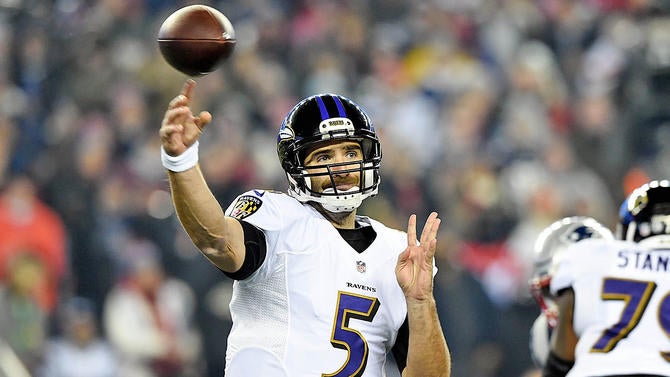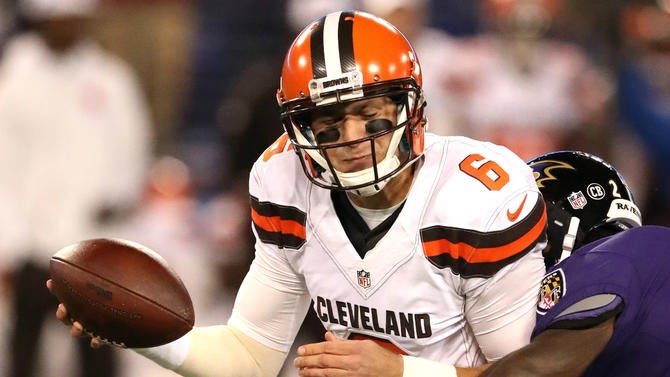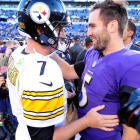In recent years, the balance of power in the AFC North shuffled among three teams: the Bengals, Ravens and Steelers. Pittsburgh won the crown in 2014 and last season; Cincinnati held the honor in 2013 and 2015 and Baltimore finished atop the division in 2011 and 2012. Since '11, these three teams have combined for exactly one losing season, which came in '16 when the Bengals slipped to 6-9-1.
Over that same span, the Browns are 24-72, the highlight coming in 2014 when they finished 7-9. Even by Cleveland sports standards, it's been downhill since; the Browns won three times in 2015 and just once last season.
The silver lining -- if you want to call it that -- is that the Browns stockpiled picks in the last two drafts and (on paper, anyway) are a much better team than they were two years ago. That's little solace to a tormented fan base, and the rebuilding process will continue for at least another season; the Browns' continue their search for a franchise quarterback, and until that issue is solved, they'll remain the laughingstocks in the AFC North.
As for the rest of the division...
So what about the Ravens' offense?
Here's the good news: The Ravens' defense -- which ranked sixth last year, according to Football Outsiders' metrics -- got a lot better this offseason.
Tony Jefferson was signed away from the Cardinals in March, and he and Eric Weddle now have a good case for one of the NFL's top safety duos. Brandon Carr adds depth at cornerback, and he'll join a unit that also includes re-signed starters at defensive back (Lardarius Webb) and defensive tackle (Brandon Williams). And we haven't even gotten to the draft class yet.
With O.J. Howard still on the board and Joe Flacco's fondness for play-making tight ends, it was something of a surprise when the Ravens used the 16th overall pick on cornerback Marlon Humphrey. Not because there are questions about how Humphrey's physical style will translate to the NFL, but because he does nothing to help an offense that ranked 24th last season, one spot worse than the 49ers.
Baltimore doubled down in Round 2, drafting pass rusher Tyus Bowser and tripled down in Round 3 with defensive end Chris Wormley. Four picks later, they took another pass rusher, Tim Williams, before finally taking offensive guard Nico Siragusa 122 picks into the proceedings.
General manager Ozzie Newsome is considered one of the league's best talent evaluators, so he had good reasons for taking the players he did when he did.
"If you would have told me yesterday at 3 o'clock in the afternoon that I was going to pick four defensive players [with the Ravens' first four picks], I would have told you that you would not be correct," Newsome after the first three rounds of the draft, via the team's website. "But that's the way it played itself out."

"When you have the best player sitting there staring you in the face, you take him," coach John Harbaugh added. "That's what we've done and it's turned out to be defense. And we're all happy with that. If it would have been four offensive guys, we would have been happy with that. This is just the way it's gone."
Still, it's also hard to reconcile the Ravens' offensive depth chart with their 2017 draft picks. Can Mike Wallace replicate his 72-catch, 1,017-yard season from 2016? Can 2015 first-rounder Breshad Perriman finally put it all together (he had 33 catches for 499 yards last season after missing his rookie campaign with an injury)? Can some combination of Nick Boyle/Dennis Pitta/Maxx Williams/Benjamin Watson/Crockett Gillmore provide Flacco with the security blanket he's relied on for much of his career? There are questions along the offensive line too, and if Siragusa shows he's capable, there's a chance he'll start as a rookie.
Put another way: The Ravens went 8-8 last season with the sixth-ranked defense. Is there any reason to believe the 24th-ranked offense, which lost Steve Smith to retirement, can improve enough to return to the playoffs for the first time since 2014?
The Bengals went on the offensive
If you would have made a list of needs for the Bengals prior to the 2017 NFL Draft, two positions that probably wouldn't have been high on that list are wide receiver and running back. For a team returning its top eight receivers from 2016 and two of its top three running backs, it would've been easy to make the argument that Cincinnati's biggest needs in the draft weren't at those two positions (I probably would've ranked them fourth and fifth, with the offensive and defensive lines being the top two needs).
The problem with drafting linemen though is that they might not contribute right away, and that's a problem because if they can't contribute in 2017, then they're no help to Marvin Lewis. The Bengals coach is headed into the final year of his contract, and he does't seem to think he'll be getting an extension before the regular season starts.
When your back's up against the wall like that, you make moves that can help you win immediately, and that's exactly what the Bengals have done.
By adding John Ross and Joe Mixon, the Bengals have added more fireworks to an offense that was already explosive, and adding more fireworks makes sense because the Bengals are nearly unbeatable when they're actually able to score points.
Bengals are 37-1-2 in their past 40 games when they score 23 or more points. Looks like their draft plan was "How do we score more points?"
— John Breech (@johnbreech) April 28, 2017
Twenty-two is actually the magic number in Cincy, with the Bengals being 37-1-2 over their past 40 games where they score 22 or more points.
Now, I know what you're thinking: "Every team is pretty much unbeatable when they're scoring points like that." However, that's not the case. In the final 40 games of the 2016 season where a team scored 22 or more points, those teams went 29-11. That .725 winning percentage is nowhere near the Bengals' percentage of .950. If you need a bigger sample size, NFL teams had a winning percentage of .721 when scoring 22 points or more during the 2016 season.
The Bengals' defense has been so good lately -- they've ranked in the top nine in opponents' points per game in five of the past six seasons -- that the Bengals have basically been able to win anytime they've been able to put up roughly three touchdowns.
Although the Bengals didn't do much in free agency, they did do a great job in the draft by basically hitting on every single one of their needs, and they did that even though they decided to gamble by using their first two picks on offensive skill players.
Players like Jordan Willis, Carl Lawson and kicker Jake Elliott should have bright futures in Cincinnati, but Lewis is only going to be around to appreciate them if his gamble on Mixon and Ross pays off.
The downside of the Bengals' plan to go all-in with their offense this season is that they forgot that they're going to need people to protect Andy Dalton. The Bengals lost two key linemen during free agency -- Andrew Whitworth and Kevin Zeitler -- which is bad news for an offenisve line that let Dalton get sacked 41 times in 2016. Dalton was the second most-sacked quarterback in the NFL last season, behind only Tyrod Taylor, who was sacked 42 times.
Of course, things could be worse for Dalton. He could play for the Browns.
The Browns' offense arguably got worse
After going 1-15 in 2016, no team had more holes to fill this offseason than the Cleveland Browns, and in what has become an annual tradition with the Browns, the team basically took one step forward, followed by two steps back, followed by three steps sideways into a giant hole.
The big step forward came in the draft when the Browns actually did the smart thing and took the best player on the board with the No. 1 overall pick, Myles Garrett. Of course, the downside of that pick is that Garrett can't play quarterback.
The Browns' biggest need this offseason -- as it has been since about 1999 -- was at the quarterback position, and the team blew it by not adding anyone that looks anything like someone who could be a capable starter in 2017.
With the No. 12 overall pick in the draft, the Browns could've taken Deshaun Watson, but they decided to pass on the Clemson quarterback and hand him to the Texans. Instead of grabbing Watson at No. 12, the Browns decided to wait 40 picks and grab DeShone Kizer in the second round (52nd overall).
Keep in mind, that's a guy who didn't even get a solid endorsement from his own college coach. Before the draft, Notre Dame's Brian Kelly said that Kizer should definitely stay in school for another year.
The Browns' depth chart at QB now reads like a "Who's Who" of players you'd never want to start at quarterback for your team. If you've lost track of who the Browns have, Kizer and Brock Osweiler will be competing with Cody Kessler and Kevin Hogan for the starting job.

You can pretty much throw credentials out the window in this competition, because no one really has any: Kizer's a rookie, Hogan's a second-year player who didn't start in 2016, Kessler went 0-8 last season as a rookie and Osweiler is Osweiler.
The worst part for the winner of the quarterback competition is that he is actually the loser, because he's not going to have anyone to throw to. In two of the most baffling moves of the offseason, the Browns let their two leading receivers from 2016 walk.
After the Redskins offered Terrelle Pryor a one-year, $8 million deal in March, the team decided not to match the offer, even though Pryor gave them the chance. The Browns also inexplicably cut tight end Gary Barnidge, who has been one of the few bright spots for the team over the past two seasons.
Although the Browns drafted Miami tight end David Njoku with the 29th overall pick, there's no guarantee he'll be a success in the NFL. If I were the Browns, I would've held onto Barnidge for at least one more season in order to make sure that Njoku was going to work out on the field. The Browns only gained $2.19 million in cap space by cutting Barnidge.
By letting Barnidge and Pryor leave Cleveland, the Browns dumped roughly 40 percent of their receiving production from 2016. Pryor and Barndige combined for 132 of the team's 338 catches last season (39.1 percent) and 1,619 of Cleveland's 3,693 receiving yards last season (43.8 percent).
Those are going to be tough numbers to replace, especially when you consider the fact that the receiving corps in Cleveland will likely have a relatively inexperienced quarterback throwing them the ball.
Now, the Browns did add Kenny Britt at receiver, but that's definitely a step down from Pryor.
The Browns seem to slowly be getting better, but it feels kind of like they've given up on 2017 in order to make sure they're more competitive going forward, and they should be considering the boatload of picks they're going to have in the 2018 NFL Draft, a collection that includes two first-rounders and three second-rounders.
When in doubt, Steelers can just score more points
Antonio Brown is the most dangerous wide receiver in football. And Martavis Bryant, who was reinstated recently after missing the 2016 season because of violating the league's substance abuse policy, may not be far behind. The problem, however, is that the Steelers can't trust Bryant to stay out of trouble; in addition to the suspension in '16, he was suspended for four games in 2015. But when he's on the field and focused ... my word. It makes Ben Roethlisberger's life immeasurably easier, and the hope is that Bryant can straddle the straight and narrow and remain on the field for the duration of the 2017 season.
Then there's Sammie Coates, the Steelers' third-round pick in 2015, who was drafted because the team knew Bryant would be suspended. Coates, like Bryant, is a burner, but after a blazing start last season, he was hampered by injuries over the final three months. There's also tight end Ladarius Green, a middle-of-the-field matchup nightmare who battled ankle injuries and concussions during his first year in Pittsburgh. If these three players show up healthy and ready to go for training camp, the Steelers' offense will be damn near unstoppable.
The Steelers must have some reservations, which explains their draft-day insurance policy in the form of second-round pick, JuJu Smith-Schuster, who will replace Wheaton on the roster but is a completely different type of receiver. Listed at 6-foot-2, 220 pounds, Smith-Schuster ran a 4.54-second 40 at the combine, and he has drawn comparisons to Anquan Boldin. He can also play inside or out, excels at making contested catches, and only offers a Plan B should either one of the wide receivers -- or any of the tight ends -- fall short of expectations. The Steelers were apparently enamored with Ole Miss tight end Evan Engram, who is 6-foot-3, 234 pounds and is more receiver than blocker.
We haven't even mentioned Le'Veon Bell, the league's most dynamic back. He averaged 4.9 yards per carry and rushed for 1,268 yards last season -- and oh by the way, he was also second on the team in receptions (75) and receiving yards (616) behind only Brown.
Yes, the Patriots own the Steelers -- and New England somehow got better this offseason -- but it's hard to argue that Pittsburgh doesn't own the NFL's most explosive offense.
Oh, and then there's the offensive line. For years a punchline, this group has quietly become the foundation to Big Ben & Co.'s success. In 2016, the line ranked second in run blocking and fourth in pass protection, according to Football Outsiders, a far cry from the indignities Roethlisberger suffered in 2011, the year before Todd Haley arrived, when he took 40 sacks and the O-line was 20th in pass blocking. Last season, Roethlisberger was sacked 17 times.
Godspeed, opposing defensive coordinators not named Matt Patricia.

















